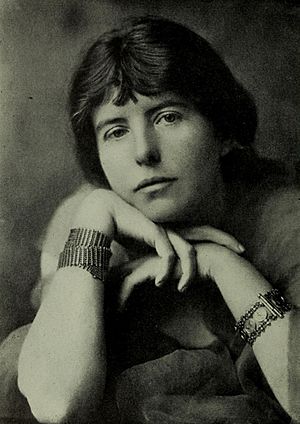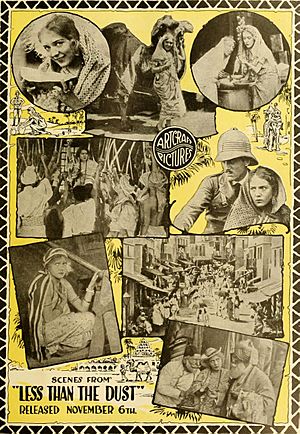Violet Nicolson facts for kids
Quick facts for kids
Violet Nicolson
|
|
|---|---|

Adela Florence Nicolson
|
|
| Born |
Adela Florence Nicolson
9 April 1865 Stoke Bishop, Gloucestershire, England
|
| Died | 4 October 1904 (aged 39) |
| Resting place | St. Mary’s Cemetery, Chennai, India |
| Occupation | Poet |
| Spouse(s) | Malcolm Hassels Nicolson |
| Parent(s) | Arthur Cory (father), Fanny Elizabeth Griffin (mother) |
Violet Nicolson (born Adela Florence Nicolson) was an English poet. She lived from 1865 to 1904. She wrote her poems using a special pen name, which was Laurence Hope. In the early 1900s, she became a very popular author. Many people bought her books.
Her Life Story
Adela Florence Cory was born on April 9, 1865. Her birthplace was Stoke Bishop, England. She was the second of three daughters. Her father, Colonel Arthur Cory, worked for the British army in India. Because of his work, Adela grew up in England with relatives.
In 1881, she moved to India to live with her father. Her father was an editor for a newspaper called The Civil and Military Gazette. He likely gave Rudyard Kipling his first job as a journalist. Adela's sisters, Annie Sophie Cory and Isabel Cory, also became writers. Annie wrote popular novels. Isabel helped their father and later became an editor too.
Adela married Colonel Malcolm Hassels Nicolson in April 1889. He was older than her. Malcolm was known for being very brave. He once crossed a river by hopping on crocodiles! He was also good at languages. He taught Adela to love India and its customs. This made them seem a bit unusual to others.
In 1890, Adela even followed her husband on an expedition. She dressed up as a Pathan boy to go through the Afghan border passes. They lived in a place called Mhow from 1895 to 1900. Adela's son, Malcolm, later published some of her poems. This book was called Selected Poems and came out in 1922, after her death.
Her Writing
In 1901, Violet Nicolson published a book of poems called Garden of Kama. It was released in America a year later as India's Love Lyrics. She first said these poems were translations of other poets' works. However, people soon realized they were her own.
Her poems often used pictures and ideas from poets in India and Persia. She was one of the most popular romantic poets of her time. Her poems usually talked about love that wasn't returned. They also spoke about sadness and loss. Many of her poems felt very personal, like she was sharing her own feelings.
It can be hard to find many details about her life. This is because she did not write many letters. However, some information comes from her son's memories. These memories were never fully published. Other writers, like Violet Jacob, also shared some details about the Nicolsons. Most of what we know about Violet comes from her beautiful poetry.
Poems in Pop Culture
Violet Nicolson's life and poems have inspired many other works.
- A British composer named Amy Woodforde-Finden set some of her poems to music. These songs were from The Garden of Kama. The most famous one was called Kashmiri Song. Later, Woodforde-Finden added more songs from Nicolson's 1903 book, Stars of the Desert.
- An American composer, Harry Burleigh, also published "Five Songs of Laurence Hope" in 1915. Another composer, Marques L.A. Garrett, later changed Burleigh's songs for a mixed choir.
- The film Less Than the Dust (1916) starring Mary Pickford was based on Nicolson's poem and song. Another movie, The Indian Love Lyrics, came out in 1923.
- Other stories and plays have been based on her life. These include The Colonel's Lady by William Somerset Maugham. This story was also part of the film Quartet (1948). More recent books include Fate Knows no Tears (1996) and That Bloody Female Poet (2011).
- In the 1910s and 1920s, dancers like Ruth St. Denis, Ted Shawn, Martha Graham, and Michio Ito created dances based on The Garden of Kama.


